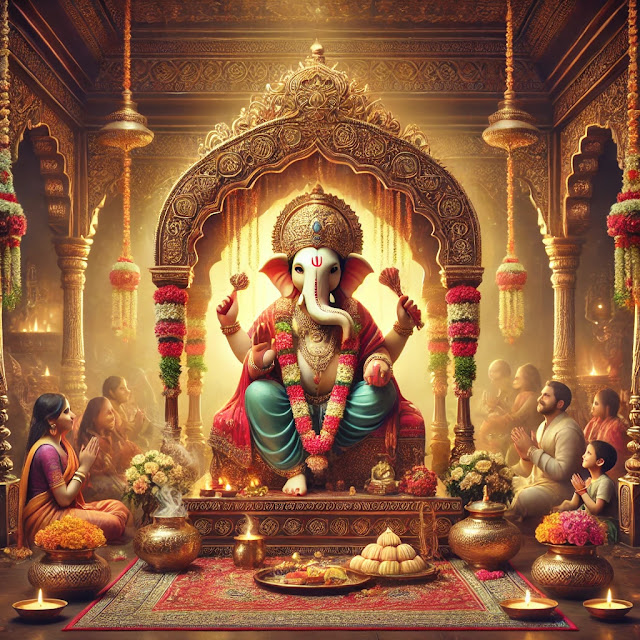Ganesha: Why We Celebrate Ganesh Chaturthi?
Ganesh Chaturthi is one of the most loved and vibrant festivals in India. Every year, millions come together to celebrate the birth of Lord Ganesha—the beloved elephant-headed god known as the remover of obstacles and the harbinger of new beginnings. But beyond the celebrations, the decorations, and the sweets, lies a deep spiritual significance. Let’s dive into the essence of this festival, its connection to ancient Vedic teachings, and why it holds a timeless lesson for all of us.
Who is Lord Ganesha?
In Hindu mythology, Ganesha is the son of Lord Shiva and Goddess Parvati. He is recognized by his unique appearance—a human body with the head of an elephant and a large belly, symbolizing wisdom and generosity. Ganesha is worshipped as "Vighnaharta" (the remover of obstacles) and "Buddhipriya" (the god of intellect and wisdom). His blessings are sought before beginning any new venture, be it business, education, or even a journey.
The Origins of Ganesh Chaturthi
The festival of Ganesh Chaturthi, according to the Vedas, is rooted in honoring Ganesha as the divine force that brings harmony, order, and balance to the world. The story goes that Lord Ganesha was created by Goddess Parvati from the sandalwood paste she used for bathing. She breathed life into him, and he became her protector. When Lord Shiva unknowingly beheaded him during a misunderstanding, Parvati was heartbroken. To console her, Lord Shiva promised to bring Ganesha back to life and replaced his head with that of an elephant, symbolizing wisdom and strength.
Thus, Ganesh Chaturthi marks the day Lord Ganesha was re-born, blessed by both Shiva and Parvati, and hailed as the god of wisdom, prosperity, and good fortune.
Why Do We Celebrate Ganesh Chaturthi?
Ganesh Chaturthi isn't just a celebration of Lord Ganesha’s birth; it’s also a time for self-reflection and new beginnings. Let’s look at the life lessons this festival offers, rooted deeply in Vedic philosophy:
1. Removing Obstacles: The Vedic Significance
The Rigveda, one of the oldest texts, speaks about Ganesha as the god who helps people overcome obstacles in life. In our daily lives, we encounter countless challenges—whether they are personal struggles, professional hurdles, or emotional blockages. The act of worshipping Ganesha signifies our desire to remove these barriers and move forward with clarity and focus.
Life Lesson: Whenever we face difficulties, we can invoke the spirit of Ganesha within us—embodying patience, wisdom, and a positive mindset—to overcome challenges. Just like Lord Ganesha, who faced the ultimate test when he lost his head but was restored with an even greater one, we too can turn our hardships into opportunities for growth.
2. Embracing Imperfections
Lord Ganesha’s appearance teaches us an important lesson: Beauty lies in imperfection. Despite having the head of an elephant, Ganesha is revered as the god of intellect and wisdom. His large ears teach us to listen more, his small eyes symbolize focus, and his large belly represents the ability to digest both the good and bad experiences of life.
Life Lesson: Embrace your flaws and imperfections. Each one of us is unique, and just like Ganesha, our quirks and imperfections contribute to our strength and wisdom. By accepting ourselves fully, we can unlock our true potential.
3. The Cycle of Creation and Dissolution
During Ganesh Chaturthi, idols of Ganesha are installed in homes and communities. After days of worship, they are immersed in water during the visarjan ceremony, symbolizing the cycle of life, death, and rebirth. According to the Vedic teachings, the universe itself goes through cycles of creation, preservation, and dissolution. Ganesha's immersion reminds us that life is transient, and nothing lasts forever.
Life Lesson: Everything in life is temporary. The visarjan teaches us to let go—to release attachments and embrace change. Holding onto things—whether material, emotional, or mental—only brings suffering. By accepting the impermanence of life, we can live more freely and peacefully.
4. Unity in Diversity
Ganesh Chaturthi is celebrated across India with joy and devotion, cutting across regional, cultural, and social boundaries. It brings people together, promoting unity and harmony. The Vedas emphasize the idea of “Vasudhaiva Kutumbakam,” meaning “the world is one family.”
Life Lesson: We are all part of a larger whole. Just as people come together to celebrate Ganesha’s birth, we must remember the importance of community, compassion, and inclusivity in our lives. When we support and uplift each other, we foster a world of kindness and collective growth.
The Deeper Meaning of Ganesh Chaturthi
While Ganesh Chaturthi is a joyous celebration, its deeper meaning lies in self-reflection and personal growth. The festival encourages us to seek wisdom in every experience, to remain grounded in the face of challenges, and to practice humility in our victories. Ganesha represents the journey toward self-mastery—overcoming ego, fear, and ignorance.
How Can We Apply This in Our Lives?
Ganesh Chaturthi is not just about praying to an idol but about internalizing the qualities that Ganesha embodies:
- Face challenges fearlessly. Obstacles are part of life. How we handle them defines who we become.
- Be wise, not just intelligent. Wisdom is about understanding life’s deeper truths, beyond just acquiring knowledge.
- Embrace change and let go. Life is ever-changing. The sooner we learn to adapt, the more peace we find.
As we celebrate Ganesh Chaturthi, let's remember that true devotion lies in applying these timeless lessons to our daily lives. By honoring Ganesha, we honor the journey of self-improvement, compassion, and wisdom that each of us is on.
So, this Ganesh Chaturthi, take a moment to reflect: What obstacles are you ready to remove from your life? What new beginnings will you embrace?
Let Lord Ganesha guide you on your path to a life filled with joy, wisdom, and peace.
Ganpati Bappa Morya!





